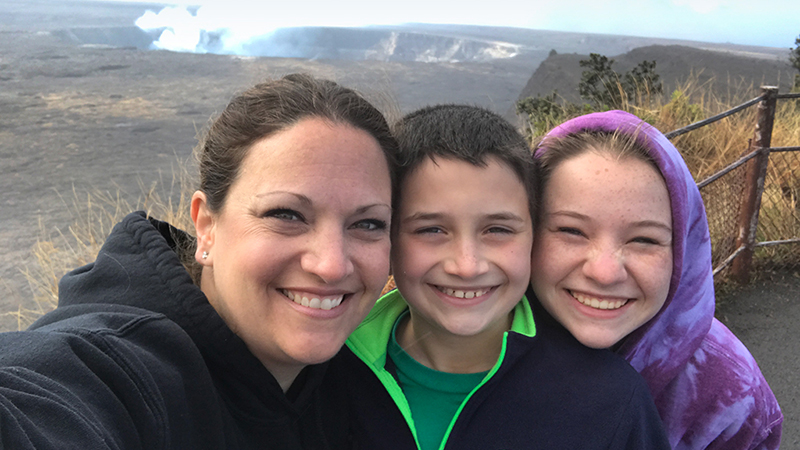
After visiting the Jaggar Museum and Overlook, we continued down Crater Rim Drive to the Kīlauea Overlook, which has basically the exact same view of Halema’uma’u Crater within Kīlauea caldera. The only real difference between the two overlooks is that the Jaggar Museum is very crowded and has interpretive displays, and the Kīlauea Overlook is practically deserted. In fact, because visitors often overlook this area, park rangers have nicknamed this lookout “Kīlauea Overlooked”.
- Kīlauea volcano is a shield volcano sitting on the south east flank of the massive Mauna Loa shield volcano. It is the youngest land volcano of the Hawaiian hot spot, the most active volcano in Hawaii, and the world’s most active volcano.
- Kīlauea Caldera is a large, almost-circular volcanic depression with vents for lava that is two miles wide, more than three miles long, and 400 feet deep. It was formed about 500 years ago by the collapse of the volcano summit into an emptied magma chamber.
- Halema’uma’u Crater is a pit crater sitting in the much larger summit caldera of Kīlauea. It was formed by hot molten magma suddenly draining from beneath the earth’s surface, causing the ground above to instantly collapse. The almost circular crater floor is 2,530 feet wide, 2,950 feet wide, and 270 feet below the floor of Kīlauea caldera and covered in a lake of molten lava.
From 2008 when the current vent, known as the Overlook Crater, inside Halemaʻumaʻu Crater first erupted, to April 2015, lava in the vent fluctuated from 20 to 150 meters below the crater floor. Then on April 24, 2015, molten lava in the vent rose to an all-time high and became visible for the first time from the Jaggar Museum Overlook at the Hawai’i Volcano Observatory.
April 29, 2015, the lava began spilling over the rim of the Overlook Crater onto the floor of Halemaʻumaʻu Crater, adding 30 feet of fresh lava to the crater floor. The lake level has since remained close to the rim, with a further minor overflow event in October 2016.
Since 1983, the lava flows on the the eastern rift zone of Kīlauea have added about 500 acres of new land to the Big Island of Hawaii. In addition to 181 homes, the national park’s Wahaula Visitors Center, the Royal Gardens Community Center, the Mauna Kea Congregational Church, and the Kalapana Drive-in have been destroyed.
Today the Halemaʻumaʻu Overlook is closed, as are hiking trails that lead to the crater. Crater Rim Drive is also closed between the Jaggar Museum and Chain Of Craters Road due to sulfur dioxide gas emissions.
Know Before You Go
- The The Kīlauea Overlook with views of the Kīlauea Caldera and Halema’uma’u Crater is located 0.6 miles from the Jaggar Museum, 0.7 miles from the Steam Vents and Sulfur Banks, and 2.2 miles from the Kīlauea Visitor Center on Crater Rim Drive in Hawai’i Volcanoes National Park.
- The current eruption rate of Kīlauea volcano is 250,000-650,000 cubic yards/day. That is enough to cover the floor of the caldera with a thin layer of lava every day.
- Most of the lava from Kīlauea is transported by lava tubes to the ocean, where it fragments, and adds layers of rubble to the submarine flank of the volcano.


